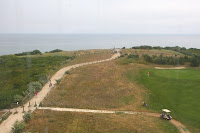Today we got to drop into the life of Dick’s sister and her partner in the town of Trurro on Cape Cod. Although they each teach in Cambridge, they have a home on Cape Cod which we had never had the chance to visit. It is a lovely house on nearly an acre of wooded land.
 Patti and Barbara got up to almost catch the sunrise on the
beach at 5:20am. Dick and Joan passed on
the opportunity. It was a lovely
morning, and great to see the scenery without so many people.
Patti and Barbara got up to almost catch the sunrise on the
beach at 5:20am. Dick and Joan passed on
the opportunity. It was a lovely
morning, and great to see the scenery without so many people.
After breakfast, we got a tour of the back road areas of
Cape Cod. Much of the island is still
wooded and seems very much in the country.
Then there are the developed areas, which are very busy and filled with
people, cars, and buildings.
We saw several little village areas around harbors and tidal estuaries. It was nice to see the special places that Barb and Joan go to.
Barbara and Joan have an adorable dog named Keesha. She was a rescue dog, rescued from Puerto
Rico. She has so much energy. They think she is about a year and a half
old, and she is quite a loving dog. She
knows how to play Frisby with herself, which is such a stich to watch. She is also very excited about chasing chip monks
and bunnies here at the Cape.
We saw several little village areas around harbors and tidal estuaries. It was nice to see the special places that Barb and Joan go to.
We really enjoyed having a special tour of “Barb’s
Lighthouse”, The Cape Cod Highland Lighthouse where Barb is one of the PT staff
people.
As in many places, the lighthouse staff are highly educated, committed individuals who enjoy sharing history and their love of lighthouses with the public. Most of these people are retired from a variety of different places, including many teachers.
As in many places, the lighthouse staff are highly educated, committed individuals who enjoy sharing history and their love of lighthouses with the public. Most of these people are retired from a variety of different places, including many teachers.
We learned that this lighthouse, like the one we saw in Cape
Hatteras, had also been moved in 1996.
Just like Hatteras, it was jacked up and moved in one piece to keep it
from falling into the ocean with erosion moving back the cliffs. We love lighthouses.
We could see the golf course where Joan often plays from the top of the lighthouse. What a beautiful setting!
We could see the golf course where Joan often plays from the top of the lighthouse. What a beautiful setting!
We also got to drive into the famous Provincetown or
P-town. This was a very busy, bustling
resort area and town. Driving through
the main street needed lots of concentration to not hit pedestrians. The main street of town was only a lane and
half wide. Many interesting people and
shops, but we didn’t have the time to really do much more than drive through
and soak it in.
At the end of Provincetown there was another lighthouse. This one you could walk about a mile or so to
on the break wall at low tide. We didn’t
have the time to do that, but were able to take some photos and enjoy another
view of a lighthouse.
Part of the peninsula is also the Cape Cod National Seashore
and has some beautiful undeveloped beach and dune areas. Thank goodness for those people who have
protected these precious natural areas.
We stopped at a couple of the beach areas and they were really
beautiful.
After lunch, Dick got caught up on some photos and blog work,
while Patti enjoyed a great nap in their backyard hammock. The temperature had dropped a bit, and
Barbara brought her a down comforter, which felt wonderful. A little rest in paradise.
Before we knew it, it was time to all pitch in to help make
a fabulous feast of fresh veggies and shrimp on the grill. All the food was wonderful. We were joined for dinner by their neighbors
and great friends, John and Claudia. It
was nice to meet their great folks and we all enjoyed a nice evening.
We finished up the night watching the opening ceremonies of
the Olympics. This is always powerful
and fun to see this demonstration of peaceful coming together of people of the
world. The ending part where Paul McCartney
led the audience in a sing-along of "Hey Jude" was really sweet.
Then off to bed, but tomorrow we head to the Boston area.
























































